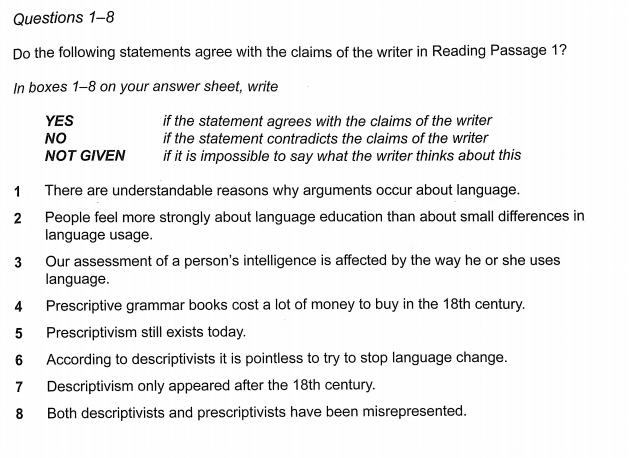剑桥雅思9阅读:Test3雅思阅读PASSAGE1真题+答案+解析
发布时间:2021-06-01 关键词:剑桥雅思9阅读Passage1
Attitudes to Language
It is not easy to be systematic and objective about language study. Popular linguistic debate regularly deteriorates into invective and polemic. Language belongs to everyone, so most people feel they have a right to hold an opinion about it. And when opinions differ, emotions can run high. Arguments can start as easily over minor points of usage as over major policies of linguisticeducation.
Language, moreover, is a very public behaviour, so it is easy for different usages to be noted and criticised. No part of society or social behaviour is exempt: linguisticfactors influence how we judge personality, intelligence, social status, educational standards, job aptitude, and many other areas of identity and social survival. As a result, it is easy to hurt, and to be hurt, when language use is unfeelingly attacked.
In its most general sense, prescriptivism is the view that one variety of language has an inherently higher value than others, and that this ought to be imposed on the whole of the speech community. The view is propounded especially in relation to grammar and vocabulary, and frequently with reference to pronunciation. The variety which is favoured, in this account, is usually a version of the Standard* written language, especially as encountered in literature, or in the formal spoken language which most closely reflects this style. Adherents to this variety are said to speak or write ’correctly; deviations from it are said to be 'incorrect!
All the main languages have been studied prescriptively, especially in the 18th century approach to the writing of grammars and dictionaries. The aims of these early grammarians were threefold: (a) they wanted to codify the principles of their languages, to show that there was a system beneath the apparent chaos of usage, (b) they wanted a means of settling disputes over usage, and (c) they wanted to point out what they felt to be common errors, in order to ‘improve’ the language. Theauthoritarian nature of the approach is best characterised by its reliance on 'rules' of grammar. Some usages are ‘prescribed’, to be learnt and followed accurately; others are 'proscribed’, to be avoided. In this early period, there were no half-measures: usage was either right or wrong, and it was the task of the grammarian not simply to record alternatives, but to pronounce judgement upon them.
These attitudes are still with us, and they motivate awidespread concern that linguistic standards should be maintained. Nevertheless, there is an alternative point of view that is concerned less with standards than with the facts of linguistic usage. This approach is summarised in the statement that it is the task of the grammarian todescribe, not prescribe -to record the facts of linguisticdiversity, and not to attempt the impossible tasks of evaluating language variation or halting language change.In the second half of the 18th century, we already find advocates of this view, such as Joseph Priestley, whose Rudiments of English Grammar (1761) insists that ‘the custom of speaking is the original and only just standard of any language’. Linguistic issues, it is argued, cannot be solved by logic and legislation. And this view has become the tenet of the modem linguistic approach togrammatical analysis.
In our own time, the opposition between 'descriptivists’ and 'prescriptivists’ has often become extreme, with both sides painting unreal pictures of the other. Descriptive grammarians have been presented as people who do not care about standards, because of the way they see all forms of usage as equally valid. Prescriptive grammarians have been presented as blind adherents to a historical tradition. The opposition has even been presented in quasi-political terms - of radical liberalism vs elitistconservatism.
……

Question 1
答案: YES
关键词: reasons, arguments occur
定位原文: 第 1 段第 2、3 句“Popular linguistic debate... ”语言学上的普通争论通常会升级为谩骂和论战。语言属于所有人,所以大多数人认为他们有权保留自己对语言的看法。
解题思路: 题干要判断对于语言的争论,原因是否可以理解。 原文陈述,语言属于所有人,大多数人有权保留对语言的看法,所以人们的观点会产生分歧是可以理解的。题干与原文完全一致。
Question 2
答案: NO
关键词: language education, language usage
定位原文: 第 1 段第 4 句“And when opinions differ,…” 而当看法出现分歧时,人们可能变得情绪激动。语言用法方面的一点小事,就能像语言学教育政策中的重大问题一样很容易引起争论。
解题思路: 题干要判断人们对待语言教育的态度是否比对待语言用法的态度更加强烈。原文陈述,语言用法方面的一点小事都能像语言学教育政策中的大事一样引起争论,这说明对待语言用法与语言学教育政策的态度同样强烈。题干与原文所述观点不一致。
Question 3
答案: YES
关键词: intelligence, affect
定位原文: 第 2 段第 2 句“No part of society or social…” 所有社会组成部分或者社会行为无一例外。语言因素影响我们如何判断一个人的个性、智力、社会地位、教育程度、工作能力以及许多身份与社会生存的其他方面。
解题思路: 题干要判断使用语言的方式是否会影响人们对一个人智力的评估。原文陈述,语言因素影响我们如何判断一个人的个性、智力……题干与原文完全一致。
Question 4
答案: NOT GIVEN
关键词: prescriptive, 18th century
对应原文: 第 4 段第 1 句“All the main languages…”
解题思路: 对所有主要语言的研究都是约定俗成的,尤其在 18 世纪对语法与词典的编写过程中。用定位词定位到的这句话中没有提到书的价格髙低与否。
Question 5
答案: YES
关键词: prescriptivism, today
定位原文: 第 5 段第 1 句“These attitudes are still with…” 这些态度现在仍然伴随着我们,并且引起人们对保留语言标准的广泛关注。
解题思路: 题干要判断现在规定主义是否仍然存在。原文陈述,这些态度现在仍然伴随着我们,题干与原文完全一致。
Question 6
答案: YES
关键词: descriptivists, language change, pointless, stop
定位原文: 第 5 段第 3 句“This approach is summarized in…” 该观点可以总结为:语法家的任务是描述而不是规定,是记录语言多样性的实例而不是试图完成评价语言的差异或阻止语言的改变这种不可能完成的任务。
解题思路: 题干要判断对于描述派来说,阻止语言变化是否毫无意义。原文陈述,语法家的任务……不是阻止语言的改变这种不可能完成的任务。题干中阻止语言变化毫无意义=语法家的任务并非阻止语言改变这种不可能完成的任务。题干与原文完全一致。
Question 7
答案: NO
关键词: after the 18th century, only
定位原文: 第 5 段第 4 句“In the second half of the 18th century,…” 在 18 世纪后半期,我们已经发现了该观点的支持者,比如 Joseph Priestley, 他在 1761 年编写的《英语语法入门》中坚持认为,“说话的习惯是最原始的、也是所有语言的唯 一标准”。
解题思路: 题干中出现 ONLY, 所以主要判断描述主义是否只有到 18 世纪后才出。原文陈述,18 世纪后半期,我们已经发现了该观点的支持者,那就意味着在这个时间以前,已经有了描述主义的观点。题干与原文陈述的时间有出入,不一致。
Question 8
答案: YES
关键词: descriptivists, prescriptivists
定位原文: 第 6 段第 1 句“In our own time, the opposition…” 在我们这个时代,“描述派”与 “规定派”之间的对立经常变得很极端,双方经常互相误解。
解题思路: 题干要判断针对这两派的描述是否有失真实。原文陈述,“描述派”与 “规定派”之间的对立经常变得很极端,双方经常互相误解。题干与原文完全一致。
Question 9
答案: H
关键词: correct form of language
定位原文: 第 3 段第 1 句“In its most general…”;第 3 段最后一句“Adherents to…” 就其最普通的意义而言,规定主义认为某种语言向来就比其他语言具有更高的价值……该语言的支持者其说话或者写作的方法被称为“正确的”方法,而任何偏差都被认为是 “错误的”。
解题思路: 原文中陈述,规定主义认为某种语言的说话或写作方法只有一种 “正确的”方法,那么持这种看法的人就是规定派、规定主义者,把 prescriptivists 带入空格中,解释为:根据规定主义者,语言只有一种正确的形式。因此选 H。
Question 10
答案: F
关键词: approach, grammatical
定位原文: 第 4 段第 3 句“The authoritarian nature of…” 该方法对语法“规则”的依赖最能体现出其独裁的本质。
解题思路: 推崇规定主义的语言学家强调语法规则。因此选 F。
Question 11
答案: A
关键词: Joseph Priestley
定位原文: 第 5 段第 4 句“In the second half of the 18th century,…”
解题思路: 在 18 世纪后半期,我们已经发现了该 观点的支持者,比如 Joseph Priestley。由此往前找,找到这句 This approach is summarised in the statement that it is the task of the grammarian to describe, not prescribe- to record the facts of linguistic diversity, and not to attempt the impossible tasks of evaluating language variation or halting language change.该观点可以总结为:语法家的任务是描述而不是规定,是记录语言多样性的实例而不是 试图完成评价语言的差异或阻止语言的改变这样不可能完成的任务。说明 Joseph Priestley 是描述主义者的代表。因此选 A。
Question 12
答案: C
关键词: Joseph Priestley, grammar
定位原文: 同上一题,比如 Joseph Priestley,他在 1761 年编写的《英语语法入门》中坚持认为,“说话的习惯是最原始的、也是所有语言的唯 一标准 ”。
解题思路: the custom of speaking = C popular speech, 即认为语法应该建立在通俗语言的基础上。因此选 C。
Question 13
答案: B
关键词: writer’s purpose
定位原文: 全篇主旨题,详见参见解题思路
解题思路: 选项 A:争论的是编写词典和语法书具体的方式,原文中没有论述,只有第四段提到了 grammars and dictionaries, 但不是作者的意图;选项 C:描述口语和书面语的区别,这与原文也没有直接关系。不过在第三段看到选项中的 spoken language, 陈述如下: “The variety which is favoured, is…style.”这里提到的具有更高价值的语言通常指的是“标准”书面语言,尤其是在文学作品或最能体现这一特点的正式口语中。这里提到的是细节,并不是意图。因此只剩下在选项 B、D 中推敲。选项 D:展现对于语言的某种看法是饱受怀疑的,这不是通篇陈述的内容,构不成作者的写作意图。所以按排除法选出选项 B:通过历史实例展示关于语言的不同观点。




